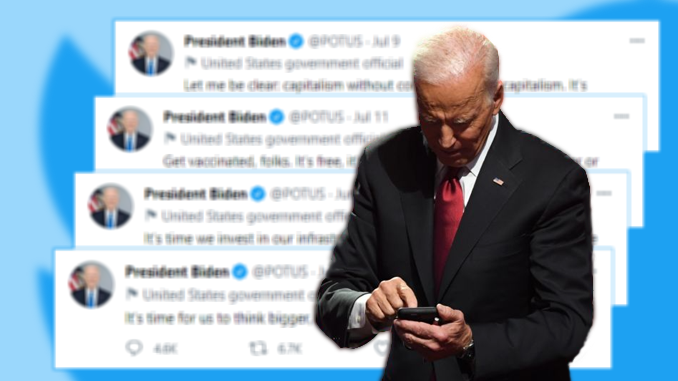
It’s Thursday…
President Biden’s public schedule for 01/25/2024:
| 8:45 AM | Out-of-Town Pool Call Time Joint Base Andrews Overhang Out-of-Town Pool |
| 9:00 AM Presidential Daily Brief | The President receives the Presidential Daily Briefing The White HouseClosed Press |
| 9:15 AM | In-Town Pool Call Time The White House In-Town Pool |
| 9:40 AM Left the White House | The President departs the White House en route to Joint Base Andrews South Lawn Open Press |
| 10:00 AM Left Joint Base Andrews | The President departs Joint Base Andrews en route to Duluth, Minnesota Joint Base Andrews Out-of-Town Pool |
| 11:00 AM Press Gaggle | Principal Deputy Press Secretary Olivia Dalton and NSC Coordinator for Strategic Communications John Kirby will gaggle aboard Air Force One en route to Superior, Wisconsin Joint Base Andrews Out-of-Town Pool |
| 12:15 PM Arrives in Duluth, Minnesota | The President arrives in Duluth, Minnesota (11:15 AM Local) Duluth International Airport, MN Open Press |
| 2:00 PM Remarks | The President delivers remarks on Investing in America and the Bipartisan Infrastructure Law (1:00 PM Local) Earth Rider Brewery, Superior, WI Open Press |
| 4:40 PM Leaves Duluth, Minnesota | The President departs Duluth, Minnesota en route to Joint Base Andrews (3:40 PM Local) Duluth International Airport, MN Out-of-Town Pool |
| 6:50 PM Leaves Joint Base Andrews | The President departs Joint Base Andrews en route to the South Lawn Joint Base Andrews Out-of-Town Pool |
| 7:00 PM Arrives at the White House | The President arrives at the White House South Lawn Open Press |
Principal Deputy Press Secretary Olivia Dalton and John Kirby Gaggle Aboard Air Force One @whenever they start it’s live at 8:00 a.m. my time (replay).
ACA/Obamacare Tweet
From Wednesday…
Today, we broke another record when it comes to ensuring Americans have access to health care:
— President Biden (@POTUS) January 24, 2024
21.3 million folks have now signed up for health coverage through the ACA.
Americans have been clear: They don’t want the Affordable Care Act repealed – they want it strengthened.
From HHS.gov…
01/24/2024:
Historic 21.3 Million People Choose ACA Marketplace Coverage:
The Biden-Harris Administration announced 21.3 million people selected an Affordable Care Act Health Insurance Marketplace plan during the 2024 Open Enrollment Period. Total plan selections include more than five million people — about a fourth — who are new to the Marketplaces and 16 million people who renewed their coverage. Notably, open enrollment continues in four states and Washington, D.C., through January 31.
“For decades, when it came to federal programs we could depend on to keep Americans covered, three were always top of mind — Medicare, Medicaid, and Social Security, but now it’s crystal clear that we need to add a fourth — the Affordable Care Act,” said HHS Secretary Xavier Becerra. “Once again, a record-breaking number of Americans have signed up for affordable health care coverage through the Affordable Care Act’s Marketplace, and now they and their families have the peace of mind that comes with coverage. The ACA continues to be a successful, popular, and important federal program to millions of people and their families. As we celebrate the success of this most recent enrollment effort, HHS will double down on the Biden-Harris Administration’s efforts to increase access to quality care and lower costs.”
“These historic enrollment numbers are a testament to the need for comprehensive, quality, affordable health insurance, and we must do everything we can to protect and expand access to coverage for all people,” said CMS Administrator Chiquita Brooks-LaSure. “Numbers do not lie: Not only is demand for Marketplace insurance coverage at an all-time high, but the Marketplaces are delivering on the Affordable Care Act’s promise to provide the peace of mind that comes with having health insurance to millions of Americans.”
The Biden-Harris Administration has continued its commitment to making health insurance available and affordable to everyone, and the Inflation Reduction Act (IRA) and the American Rescue Plan continue to keep Marketplace coverage affordable. Thanks to the IRA, four in five HealthCare.gov customers were able to find health care coverage for $10 or less per month for plan year 2024 after subsidies. Additionally, the administration issued almost $100 million in Navigator Awards, allowing organizations to hire staff trained to help consumers find affordable, comprehensive health coverage. Navigators, as they are known, have been key to helping consumers in every Marketplace state.
These steps expanded access to affordable, comprehensive Marketplace coverage for millions of middle- and lower-income families nationwide. Compared to the Open Enrollment Period last year, nearly 4.2 million more individuals with household incomes less than 250% of the federal poverty level (about $75,000 per year for a family of four) enrolled in 2024 coverage — demonstrating that when coverage is affordable, people sign up. Marketplace coverage has also been critical for many people transitioning from Medicaid or the Children’s Health Insurance Program (CHIP) as states conduct eligibility renewals, which restarted last year. As of December 31, 2023, CMS data show that 2.4 million plan selections in states that use HealthCare.gov, or approximately 15%, were made by individuals who were previously enrolled in Medicaid or CHIP coverage.
The federal 2024 Marketplace Open Enrollment Period ran from November 1, 2023, to January 16, 2024, for states using the HealthCare.gov platform. State-based Marketplace enrollment deadlines vary. State-specific deadlines and other information are available in the State-based Marketplace Open Enrollment Fact Sheet – PDF.
Coverage opportunities remain available now that the annual Open Enrollment Period has ended. Individuals eligible for Medicaid or CHIP may enroll in coverage anytime year-round. For those no longer eligible for Medicaid or CHIP, a special enrollment period is available to enroll in Marketplace coverage. Additionally, eligible individuals with household incomes less than 150% of the federal poverty level (approximately $22,000/year for an individual and $45,000/year for families of four) can enroll in Marketplace coverage anytime through a special enrollment period. Consumers who experience a change of life circumstance — such as marriage, birth, adoption, or loss of qualifying health coverage — may also be eligible for a special enrollment period.
The Biden-Harris Administration encourages consumers to visit HealthCare.gov to see if they are eligible to enroll in a low-cost, quality health plan. Because of continuing provisions in the Inflation Reduction Act, CMS expects nine out of 10 customers to be eligible for savings. Visit HealthCare.gov for more information.
Individuals wanting assistance signing up for coverage may go to Find Local Help on HealthCare.gov to find a Navigator, Certified Application Counselor, or agent or broker: https://www.healthcare.gov/find-assistance/.
HHS.gov. 01/24/2024.
| Marketplace and Consumer Type | Cumulative 2024 OEP Plan Selections |
|---|---|
| Total: All Marketplaces | 21,310,538 |
| New Consumers | 5,045,290 |
| Returning Consumers | 16,265,248 |
| Total: HealthCare.gov Marketplaces | 16,363,133 |
| New Consumers | 4,226,461 |
| Returning Consumers | 12,136,672 |
| Total: SBMs1 | 4,947,405 |
| New Consumers | 818,829 |
| Returning Consumers | 4,128,576 |
1 In addition to reported plan selections, New York and Minnesota have a Basic Health Program (BHP), which provides coverage to consumers with household incomes at or below 200% of the federal poverty level who are not eligible for Medicaid or CHIP and otherwise would be eligible for a QHP. As of January 13, 2024, New York had a total of 1,204,722 individuals enroll in a BHP. Minnesota’s BHP data was not available at the time of this report.
To view the Marketplace enrollment snapshot report, please visit: https://www.cms.gov/newsroom/fact-sheets/marketplace-2024-open-enrollment-period-report-final-national-snapshot
Find out more via key highlights and improvements and infographic – PDF for the Marketplace 2024 Open Enrollment Period. For more information about how to enroll in Marketplace coverage, visit HealthCare.gov, CuidadoDeSalud.gov or your State-based Marketplace.
HHS.gov. 01/24/2024.
From the White House…
01/24/2024:
Today, we broke another record when it comes to lowering costs and ensuring Americans have access to quality, affordable healthcare: 21.3 million Americans have signed up for health coverage through Affordable Care Act marketplaces. That means 9 million more people have gained coverage under the law – and peace of mind – since I took office. It’s no accident. My actions to protect the Affordable Care Act and lower premiums continue to make a big difference. And the American people have made it clear: they don’t want the Affordable Care Act weakened and repealed – they want it strengthened and protected.
We need to build on the progress we’ve made by making lower premiums permanent. But Republicans in Congress have a different vision. Their recent budget would get rid of the improvements I signed into law, raising costs for millions of people. Over the last decade, extreme Republicans in Congress have blocked efforts to lower health care costs, and they’re still trying to end the Affordable Care Act, just as my predecessor tried and failed to do. Repealing the Affordable Care Act would throw these 21 million people off their coverage, and end Medicaid coverage for millions more. It would return to the days when insurance companies could rip Americans off by denying coverage based on pre-existing conditions, charge women more than men, and make older adults pay astronomical health care premiums based on their age. We must not and will not go back.
If the extreme Republicans in Congress get their way, millions of families would face skyrocketing health care costs or lose their health care altogether. I won’t let it happen on my watch, and I’ll keep fighting to bring down health care and prescription drug costs.
White House.gov. 01/24/2024.
This Week We Learned Tweet
From Wednesday…
This week we learned that nearly half of all states achieved their lowest unemployment rate on record last year.
— President Biden (@POTUS) January 24, 2024
From the White House…
01/23/2024:
The Labor Market Recovery Has Been Strong Across the Country (CEA Blog):
The U.S. labor market recovered rapidly from the 2020 recession. Since January 2021, the economy has added over 14 million jobs, while the unemployment rate reached a 50-year low with record lows for Black workers, workers with disabilities, and workers without a high school diploma. President Biden has prioritized the labor market recovery by signing into law a set of policies—including the American Rescue Plan, a robust recovery package in the wake of the COVID-19 pandemic, and major investments in infrastructure and domestic manufacturing—intended to provide opportunity for American workers across the country.
However, the headline labor market numbers can obscure geographic variation. This blog analyzes the Bureau of Labor Statistics’ monthly State Employment and Unemployment data release, looking at the maximum and minimum state unemployment rates back to 1976 (the first year that data were collected for all states) to better understand the health of the labor market and the well-being of workers across the country. Our analysis indicates that compared with previous recessions, the recovery from the 2020 recession was remarkably equitable across states.
Historically, variation in state unemployment rates rises during recessions as certain states are hit disproportionately hard. This was particularly true in April 2020, at the height of the 2020 recession, when the state unemployment rates ranged from as high as 30.6 percent in Nevada—where more people live in urban areas and the economy is largely oriented around service industries particularly affected by COVID-related shutdowns—to 5.2 percent in Wyoming—where more people live in rural areas and employment is more evenly distributed among goods-producing and service industries. In April 2020, the gap between the highest and lowest state unemployment rates reached a staggering 25.4 percentage points, a new record by a substantial margin (Figure 1).
White House.gov. 01/23/2024.
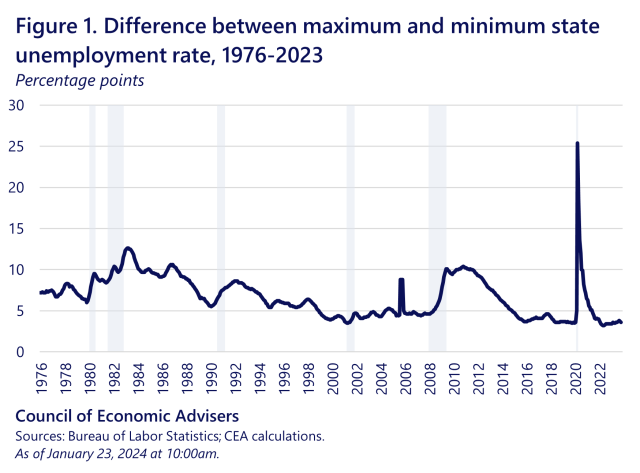
In the recovery from the pandemic, the gap between the highest and lowest state unemployment rates fell rapidly, hitting a record low at 3.2 percentage points in 2022 (previous record lows were in 2001 and 2019 when the labor market was at full employment). The shrinking of this gap came from a decline in the maximum state unemployment rate, which reached a record low of 5.2 percent (Figure 2) and occurred even as the minimum state unemployment rate also reached a record low of 1.6 percent (Figure 3). The remarkable 1.6 percent unemployment rate was in Maryland in September of 2023—it was the lowest state unemployment rate on record.
White House.gov. 01/23/2024.
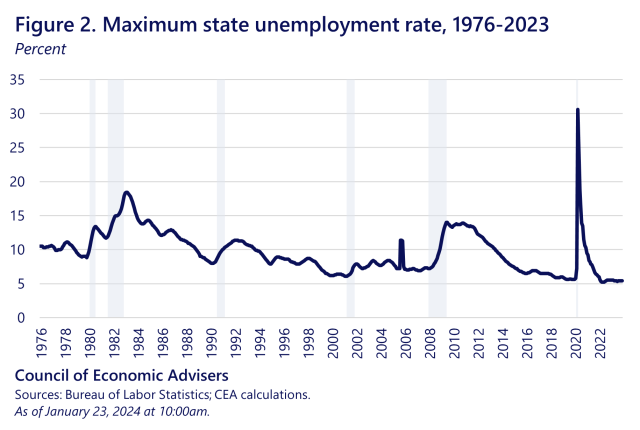
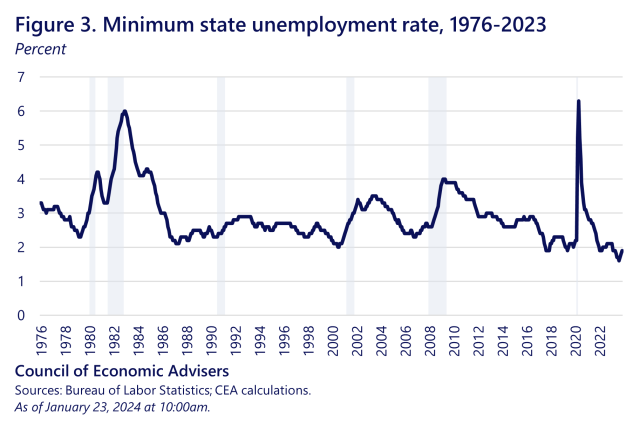
This rapid recovery is particularly striking in comparison with past recoveries. In the recovery from the Great Recession, for example, it took 69 months for the maximum unemployment rate to return to its pre-recession level of 7.2 percent. Following the COVID-19 recession, it took less than two years for the maximum state unemployment rate to recover to the pre-recession level (Figure 4a). Looking at the standard deviation in state unemployment rates reveals similar trends (Figure 4b).
White House.gov. 01/23/2024.
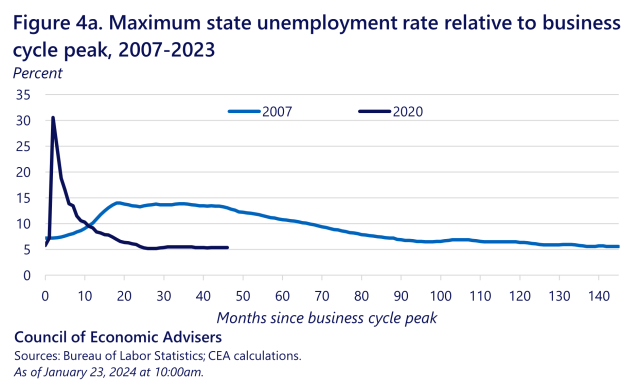
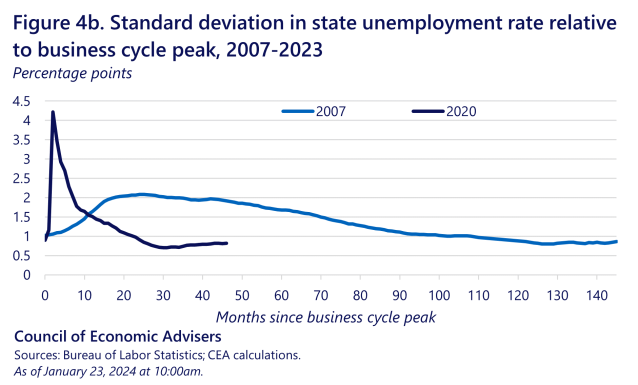
Moreover, state unemployment rates have stayed strikingly low (Figure 5). Over the course of 2023, 23 states set new record low unemployment rates. In the latest data released today, the lowest state unemployment rate was 1.9 percent. Meanwhile, the highest state unemployment rate was 5.4 percent—lower than at any point between 1976 and 2021 for the 22nd consecutive month. Such tight variation in state unemployment rates is not a foregone conclusion, and illustrates that if labor market gains are enjoyed equitably, then extraordinarily low national unemployment rates can translate into similarly low rates of joblessness across states and regions.
White House.gov. 01/23/2024.
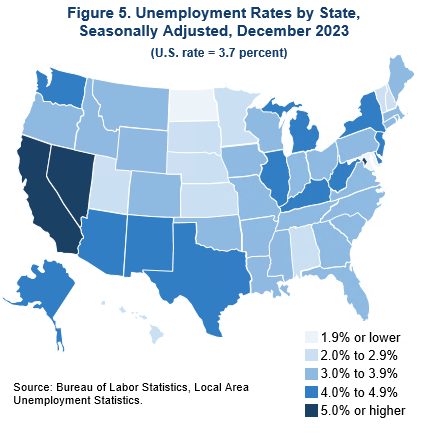
Past analyses by the Council of Economic Advisers have pointed to the relatively equitable COVID-19 recovery along racial and gender dimensions. Another central goal of the Biden-Harris Administration’s policies is equity across geographic boundaries. These state-level data provide further indication that the benefits of the strong labor market are spread across the states.
White House.gov. 01/23/2024.
Mayors Are Cool Tweets
From Wednesday…
There’s a reason I brag on Mayor Duggan and Detroit – they embody the comeback that’s happening across America.
— President Biden (@POTUS) January 24, 2024
Mike knows it’s not just about the investment, but the scholarships created from it. I couldn’t be prouder to see our Rescue Plan work for working folks in Detroit. pic.twitter.com/yVjL0nXIDt
The video clip is 1 minute and 2 seconds long.
From Thursday…
As a Scranton kid, hearing about my hometown's comeback means that much more.
— President Biden (@POTUS) January 25, 2024
Mayor Cognetti says it best: “Confidence spurs more confidence."
That’s what our American Rescue Plan was all about – reminding towns and small businesses across our nation what they’re capable of. pic.twitter.com/K2XsAqMm2m
The video clip is 1 minute and 57 seconds long.
As I’m running late, I will not be transcribing either video.
Joliet, Illinois Shooting Tweet
From Wednesday…
Again, our country mourns after the loss of eight souls stolen by the tragic shootings in Joliet, Illinois.
— President Biden (@POTUS) January 24, 2024
It is within our power to stop the epidemic of gun violence tearing our communities apart. Congress must act now. pic.twitter.com/0OQWFunGb2
From the White House…
01/242024:
Statement from President Joe Biden on Shootings in Joliet, Illinois:
Jill and I are praying for the family members of the eight victims killed in Joliet, Illinois, and for the broader community devastated by these tragic shootings.
White House.gov. 01/24/2024.
Federal law enforcement agencies assisted local law enforcement with the investigation.
This tragedy underscores why I am doing everything in my power to keep guns off our streets and out of the hands of those who seek to harm themselves or others. It’s why my administration is strengthening the gun background check system and cracking down on gun trafficking through the Bipartisan Safer Communities Act. It’s why I’ve taken dozens of executive actions to strengthen gun safety and end the gun violence epidemic. And it’s why I continue to call on Congress to pass universal background checks and a national red flag law, in addition to other commonsense gun safety measures.
It is within our power to stop the epidemic of gun violence tearing our communities apart. Congress must act now.
CBS News: Eight people were found shot and killed in three different locations over two days in Joliet, and the suspect in the slayings was also found dead by a suspected suicide 1,200 miles away Monday night, police said.The apparent self-inflicted gunshot death of 23-year-old Romeo Nance in Texas followed a manhunt by multiple law enforcement agencies.
Economy Tweets
From Wednesday…
2.7 million jobs were created last year — more than during any year under my predecessor. pic.twitter.com/keTiyS3sCD
— President Biden (@POTUS) January 24, 2024
From Thursday…
I'm headed to Superior, Wisconsin today to make a big announcement about one of the most important bridges in the region: The Blatnik Bridge.
— President Biden (@POTUS) January 25, 2024
From the White House…
01/25/2024:
Today, President Biden will visit Superior, Wisconsin, where the Blatnik Bridge connects Wisconsin and Minnesota, to announce nearly $5 billion in funding for major transportation projects across the country as part of his Investing in America agenda. A key pillar of Bidenomics, the President’s Investing in America agenda—including the Bipartisan Infrastructure Law, the CHIPS and Science Act, and the Inflation Reduction Act—is making long overdue investments in infrastructure, unleashing a clean energy and manufacturing boom, and creating good-paying jobs, many of which do not require a college degree. To date, the Administration has announced over $400 billion in Bipartisan Infrastructure Law funding for over 40,000 infrastructure projects across the nation, and has mobilized over $640 billion in private sector manufacturing and clean energy investments in the United States. And, since day one of the Biden Administration, over 670,000 construction jobs and 210,000 clean energy jobs have been created in communities across the country.
Two years ago, after he signed the Bipartisan Infrastructure Law, President Biden visited the Blatnik Bridge and highlighted the vital yet deteriorating bridge as the type of infrastructure that he would rebuild across the country. Today’s announcement—a transformative $5 billion investment that includes $1 billion to replace the Blatnik Bridge itself—is a key example of the President following through on that commitment. Due to its poor condition, the current Blatnik Bridge is predicted to close by 2030, and this new investment will change that by expanding weight capacity to accommodate freight, building wider shoulders to improve safety, and increasing accessibility for pedestrians and cyclists. During his visit to Wisconsin, President Biden will highlight the impact of the Blatnik Bridge investment on people in the community—including small business owners who rely on timely orders, deliveries, and commutes for their customers and employees; families that need to cross the bridge safely and with less traffic; truck drivers whose loads are too heavy for the current bridge; workers who will be hired on the project, and more. The President will meet with a small business owner who says his local business—and the downtown community in Superior—will benefit from the new Blatnik Bridge.
In addition to the Blatnik Bridge, key projects from today’s announcement include: replacing the I-5 Bridge over the Columbia River between Vancouver, Washington, and Portland, Oregon, which carries over 143,000 vehicles per day and no longer meets the needs of commerce and travel; improving 10 miles of I-10 through the Gila River Indian Community and Pinal County in Arizona; making multimodal improvements in the I-376 corridor of Pittsburgh; and reconnecting communities divided by the Cross Bronx Expressway in New York, which displaced residents and separated communities when constructed in the mid-1900’s. These historic projects will create good-paying jobs, make our transportation systems safer and more resilient, and unlock economic opportunity for communities across in every corner of the country. Overall, half of the funding announced today – nearly $2.8 billion – is going to projects in rural areas. These investments also build on historic funding that President Biden has announced over the past year—including $1.7 billion through the Mega and INFRA programs early last year, $2.1 billion through the Bridge Investment Program, and major rail announcements at the end of 2023—$16.4 billion to modernize Amtrak’s Northeast Corridor and $8.2 billion for world-class rail, including the country’s first high speed rail projects.
Already, the projects funded by previous announcements are hitting major milestones. For example, thanks to $1.6 billion in funding, construction to upgrade the existing Brent-Spence Bridge and build a new bridge along this critical freight corridor is expected to begin this year. In addition, thanks to the $11 billion investment from the Biden-Harris Administration, construction is now underway to replace the over 100-year-old Hudson River Tunnel between New York and New Jersey, which serves 200,000 passengers daily and is a source of frequent delays. Early work is now underway to replace the 150-year-old Frederick Douglass Tunnel in Baltimore, thanks to $4.7 billion from the Bipartisan Infrastructure Law. Work is also underway to construct the 10.3-mile St. Paul Gold Line Bus Rapid Transit system that will serve nearly 2 million passengers annually thanks to $240 million in funding. Thanks to $198 million in Bipartisan Infrastructure Law funding, construction is also ongoing to extend the Phoenix Northwest Light Rail which will serve about 2 million passengers per year. Finally, due to a $84.5 million investment, upgrades to Boston Logan Airport’s Terminal E are now complete, with increased capacity, improved energy efficiency, and new passenger waiting areas.
White House.gov. 01/25/2024.
Funding announced today will support 37 projects across the country, including:
- $1.06 billion to replace the Blatnik Bridge connecting Superior, Wisconsin with Duluth, Minnesota. The Blatnik Bridge is a 1.5-mile-long bridge that connects Duluth, MN, and Superior, WI, often referred to as the “Twin Ports”. The current bridge is weight restricted and cannot carry large or heavy trucks, causing lengthy detours for regional freight. The replacement bridge will increase capacity and create a new shared-use path for pedestrians and bicyclists.
- $600 million to replace the over 100-year-old I-5 Bridge—a critical connection linking Oregon and Washington across the Columbia River as part of a vital regional, national and international trade route. This project will replace the aging bridge with a modern, earthquake-resilient, multimodal bridge. It will also add safety shoulders and auxiliary lanes, include add transit improvements, and create safe and accessible shared use paths.
- $427 million for the Humboldt Offshore Wind project in California. The project will establish the first offshore wind terminal on the Pacific Coast. The terminal will support the transport, assembly, launch, and maintenance of floating offshore wind turbines.
- $372 million to replace the 80-year-old Sagamore Bridge, one of the Cape Cod Bridges that spans the Cape Cod Canal and provides the only vehicle access to the Massachusetts mainland from Cape Cod.
- $300 million for the Louisiana International Terminal Project to construct a new container terminal on the Gulf Coast for the Port of New Orleans. The new terminal will be a new alternative for larger vessels compared to inland terminals that have height restrictions.
- $200 million for the Hood River White Salmon Bridge in Oregon and Washington. The project will replace the bridge between Hood River, OR, and White Salmon, WA, which serves as a critical link for freight and provides hospital access and a wildfire evacuation route. The current bridge is structurally deficient, and the replacement will have higher clearance, wider lanes, seismic improvements, and a separate bicycle and pedestrian pathway.
- $150 million to reconnect communities divided by the Cross Bronx Expressway between the Harlem River and the Hutchinson River Parkway in New York—one of the most congested stretches of interstate in the U.S. with some of the highest rates of traffic and collisions. The project will improve pedestrian, bicycle, and transit connections across the highway and along parallel routes, expand open space, increase safety on local routes along the corridor, and improve traffic management, especially for freight vehicles. The Expressway was constructed between 1948 and 1972 and divided the borough, displacing residents and separating communities.
- $95 million for the Gila River Indian Community I-10 Project in Arizona. The project will widen approximately 10 miles of I-10 in Pinal County from two lanes to three lanes, make interchange improvements and build a new interchange, and remove or replace low-clearance bridges along the route. The project will improve safety, increase capacity, and provide job opportunities for the Gila River Indian Community.
- $66 million for the Mineral County I-90 Improvement Project in Montana. The project will reconstruct almost six miles of I-90, making resilience, drainage, and safety improvements, and replacing three bridges on westbound I-90.
- $28 million for the Elko Nevada Rail Corridor Enhancement project in Nevada. The project will make improvements on the Union Pacific Railroad at the Elko Yard. Track improvements, infrastructure upgrades, and enhanced signal infrastructure will reduce an average of 2.5 hours of delay per freight train using the corridor.
- $15 million for the East River Terminal Berth Replacement project in Georgia. The project will replace three berths at the Port of Brunswick’s East River Terminal, as well as support growing export of wood pellets at the port.
President Biden Delivers Remarks on Investing in America and the Bipartisan Infrastructure Law @2:00 p.m. D.C., time:
“New” from the White House…
01/24/2024:
- Remarks by President Biden at a Campaign Event | Manassas, VA; the YouTube is 49 minutes and 13 seconds long.
- Remarks by Vice President Harris at a Campaign Event | Manassas, VA; the YouTube is 49 minutes and 13 seconds long.
- Press Briefing by Press Secretary Karine Jean-Pierre and NSC Coordinator for Strategic Communications John Kirby; the YouTube is 44 minutes and 12 seconds long.
